Neandertals Hunted and Feasted on Giant Prehistoric Elephants
Recently, research further concluded that Neandertals were carnivores based on results from zinc isotope analysis. We know they likely ate meat, but questions remained regarding what type of meat they likely ate. Luckily, we didn’t have to wait long to learn about at least one component of the Neandertal diet: prehistoric elephants.
A new study led by Sabine Gaudzinski-Windheuser from the Archaeological Research Center and Museum of Human Behavioral Evolution in Germany recently discovered that Neandertals hunted and butchered giant prehistoric elephants. This practice would have given them massive amounts of meat that could have fed hundreds of people.
At the Neumark-Nord 1 site near present-day Halle, Germany, researchers excavated 3,122 elephant remains between 1985-1996. The remains included more than 70 individuals belonging to an extinct species called Palaeolozodon antiquus, the straight-tusked elephant. These were massive animals: they were more than 13 feet tall and weighed about 13 tons (equivalent to about eight cars!).
A recent reexamination of the fossils found strategic, repetitive cut marks along the surface of the bones, suggesting that the Neandertals butchered these animals. Researchers estimate that the dismembering process took between 200 and 600 hours if done by one person. But, the reward was worth it. There would have been an estimated 2,500 daily portions of about 4,000 calories each. In other words, the research team suggests that one elephant could have fed about 25 Neandertals for three months (or, 100 for one month, 350 for one week). In other words, these elephants were enormous calorie bombs when consumed.
The markings on the bones suggest that the Neandertals used every bit of the elephant that they could, right down to the pads of fat on the bottom of their feet. The absence of tooth marks on the bones suggests that there was not much meat left for scavenging by other animals.
It’s thought that these massive animals were chased into a pit or muddy area, where they were then shot with spears. Basically, the Neandertals would work to immobilize the elephants so their weight would work against them by trapping them in mud before finishing them off. Moreover, most of the remains found at the site belonged to older, male elephants. Males often roamed alone (as compared to females, who stayed in groups to protect their young) making the males an easier hunting target.
The find suggests that Neandertals knew what they were doing. There was a lot of effort put into the hunt and butchery, and they would not want to waste this. Archaeologists assume that Neandertals must have known how to store and preserve meat by smoking or drying it.
These findings also offer more support for how Neandertals may have lived. There already has been evidence that they lived in groups, and cared for each other. The effort it took to hunt these animals, combined with the shear amount of meat that was collected from them, lends further support for the theory that Neandertals lived in communities.
Sources: Labroots (October 2022), Science Advances, Smithsonian Magazine, Labroots (February 2023), The Guardian, New Scientist, New York Times









